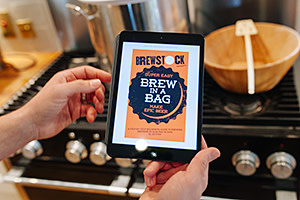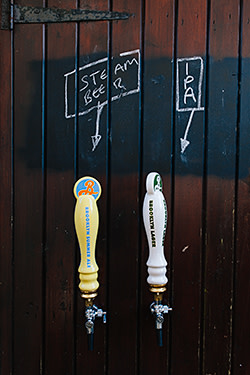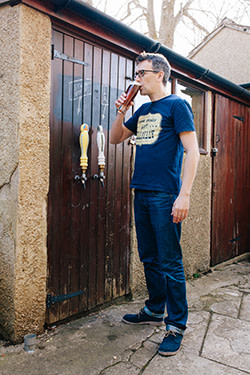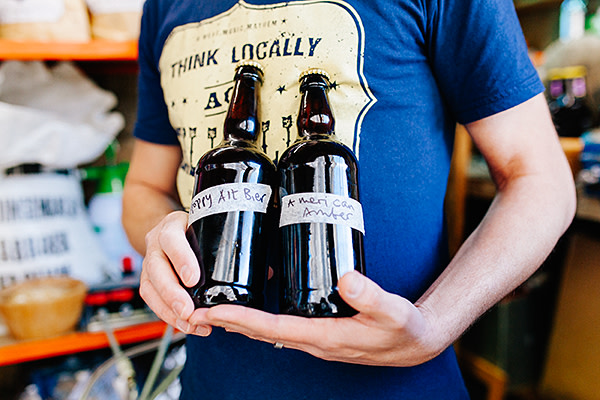Home brewing is cool again

Simply sign up to the Life & Arts myFT Digest -- delivered directly to your inbox.
It’s quite possible that you’ve never experienced home-brewed beer. Unless you did an engineering degree, had a dodgy uncle in the 1970s or have spent time in prison, you’ve probably been able to avoid it. “Home brew” has an awful reputation, justly earned by years of exploding bottles and plastic dustbins full of evil sock-rank fluids, bubbling in understairs cupboards.
Brewing at home was associated with some profoundly unappealing stuff. The sandals, socks, beards and sweaters of the real-ale fundamentalists; the desperation of impoverished students and beer “kits”, packs of concentrated ingredients put together by commercial brewers enabling people to make a facsimile of popular pub beers while avoiding duty.
But things are changing. The kind of nerd foodists who should, by any normal standards, be dropping £7 a bottle on micro-brewed craft beers, imported at great cost from halfway round the globe, are suddenly doing it themselves. Perhaps the only thing that has stayed the same is the beards and sandals – the ironic uniform of the hipster – but otherwise they are using new techniques, equipment and ingredients. Empowered by internet subculture, home brewing is back at the cutting edge.
Jon Finch all but personifies the new food entrepreneur. Starting with a pop-up tent stall, he brought US barbecue to Bristol. He now presides over Grillstock, an annual music and barbecue festival in Bristol and Manchester, and a restaurant, Grillstock Smokehouse, in Bristol’s Clifton area, where we meet. “I’d always wanted to make beer but I didn’t like the idea of using kits . . . all that gloopy stuff,” he says. “I heard about this technique they were using in Australia – brew-in-the-bag, which, basically, gives you unlimited creativity with your beer, the same as a large-scale brewery.”

In traditional brewing, malted grains are boiled to create a liquid called “mash” containing natural sugars and carbohydrates. The liquid, or “wort”, is strained off and the yeast is added, which, over a couple of weeks, turns the sugars into alcohol. If the brewer adds hops, it makes the finished product more bitter and if he chooses to store it in a closed container, a bottle or a keg, then the carbon dioxide gas given off during the fermentation process is trapped in the beer, making it effervescent.
In the past, home-brew kits have usually contained a concentrate of the wort, industrially produced and sealed in a tin can – a sort of sweet Marmite – which had to be dissolved in hot water before the yeast was added. Brew-in-the-bag is one of several game changers. The brewer can buy his own grain, boil it up in a large saucepan and then pour it into a cloth bag – a clean pillowcase will do the job – which filters the wort into a cheap plastic bucket. Finch compiled his knowledge and experience of the technique into a book, Brew In A Bag – Make AWESOME All-Grain Beer At Home.

“I think there’s a lot of mystery to brewing, a lot of tricky terminology but this brew-in-the-bag technique made me think, actually, it’s not hard. If you can cut through all that, as I say in the book, if you can make soup, you can make beer. You basically make a wheat soup, add yeast and leave it – that’s beer.”
Another change that has made high-quality home brewing possible is improved understanding of and technology for sterilising the equipment. Home brewers of previous generations spent many hours with boiling water and smelly chlorine-based bleaches, trying to wipe out every possible bacterium that might taint a batch. Brewing is really all about bacterial action but if the wrong strains flourish the results can be truly unpleasant. Lack of sterility was the single greatest cause of failure and the long and thankless processes of cleaning put most home brewers off. A single product, though, originally used in commercial food preparation but suddenly available to domestic users is credited by almost all the new brewers, for making the whole process manageable.
“My first few batches tasted, well, I guess like home brew: smelly and flat with that awful tang to it,” says Finch. “Then somebody suggested I try Star San, which you just spray on and leave and it sterilises everything. I’m a really lazy brewer. I’m not a guy who can spend a whole day brewing beer, I just want to make it quick and easy and have great-tasting beer.”
There can’t be many areas of human knowledge where the internet hasn’t spread its tendrils but what’s surprising is the level to which the ancient art of brewing has been advanced by it.
In the magical way it does, the web has connected home brewers and created a market for ingredients from all over the globe. Commodity grain for the basic mash is usually easy to obtain in the brewer’s home country but there is now a thriving trade worldwide for the arcane breeds of hop and the specialist strains of yeast that make a beer unique. A home brewer in a shed in Sheffield is only a click away from, for example, hops grown only in the US or a yeast traditionally used only in parts of the Czech Republic. With such a palette of base ingredients now available, with a kind of “crowdsourcing” of recipes and a simplification of the technology, brewing has undergone a step change.

“If, for example, I like Brooklyn lager,” says Finch, “I can do a bit of research on the web – there’ll be a recipe out there. I know for a fact that I can buy all the ingredients online and, four weeks later, I can be drinking my own version, just fresher.
“At the moment I’ve got four kegs in my shed with beer taps on the door. My friends and neighbours come round; even when I’m not home, with empty glasses, pour a pint from the shed, take it home and sit in the lounge drinking it. At the moment, I’ve got my regular house pale ale, I’ve got my Christmas beer still hanging around, I’ve got a big IPA on and I’m currently making a Steam beer – a California Common and I’m conditioning a Brooklyn Lager clone.”
…
James Morton is in the final stages of qualifying as a doctor. In 2012, he was a runner up in The Great British Bake Off and has published a successful book on breadmaking but his interest in fermentation spreads far wider. “I came across the home-brew competitions via the brewing forums. Places such as homebrewtalk.com in the US and jimsbeerkit.co.uk in the UK are chock-full of information, tips and background.”
Morton entered his Oatmeal Extra Pale into the National Home Brewing Awards, which are sponsored by Dark Star Brewing Co, an established brewery that is branching out into craft beer.
“[The Oatmeal Extra Pale] is an American style pale ale with extra hops and oatmeal added. I add oatmeal to all my brews, it gives amazing ‘mouth feel’. I thought I’d at least have a go,” says Morton. “The point of most competitions is just to get the feedback so you can improve.” Morton’s beer will still end up going into commercial production by Dark Star. “Hobbyists” such as Morton are being taken very seriously by much larger commercial players.
I asked Pete Brown, beer writer and champion of the resurgence in British beer, whether we should be taking home brewing so seriously. “Absolutely. Thornbridge Brewery sponsor a home-brew competition every year. I was a judge this year using the same judging criteria we’d use for the Siba [Society of Independent Brewers] competitions between established regional brewers. The results were of stunning quality. I forgot I was tasting home brews.”
Brown says “Gone are the days when you bought a kit from Boots and boiled a kettle to make beer in your kitchen. Home brewers have access to the same ingredients as the pros but they can experiment more, learn quicker from their mistakes and the risks are lower.”

Brown recently spoke at a workshop for entrepreneurs hoping to start their own food businesses. Of the 100 people paying £100 a time to attend, he reckons 75 were home brewers. “For this new generation, he says, “scaling up from home brewing to a three-barrel brewery (the smallest-scale commercial operation) is easy”.
Given the intersection with coffee and the hipster crowd, it was perhaps inevitable that nano-brewing should go high-tech. The Brewbot is the bafflingly brilliant product of Cargo design and marketing agency in Belfast. It had been successful in designing consumer interfaces and apps for dozens of large companies but wanted a project where it could see physical results. As beer fans and confirmed geeks, the answer was as obvious as it would seem as bonkers to the rest of us. A mini-brewery, designed as a free-standing appliance, controlled by a computer and operated via a smartphone app.
Founder Chris McClelland explained the background. “There’s a mass of information on brewing around the web but it’s difficult to understand. We saw that there was an opportunity there – people who wanted to brew but just couldn’t get started – and we wanted to create something that would give them a head start.”
As many small businesses in the tech sector do, Cargo decided to fund the Brewbot via Kickstarter and was inundated with subscribers. At around £1,000 per unit, the Brewbot is about as far away as you can get from a plastic bucket. A series of stainless steel tanks with interconnecting pipes, valves and filters is concealed in a smart reclaimed timber case. It’s an odd combination of domestic, functional and ruggedly cool, like a tumble dryer with tattoos.
“The Kickstarter backers are a really interesting phenomenon. It’s like an army of supporters. They obviously back us financially – which is brilliant – but they’re also the kind of people who actually contact us with information and feedback. We’ve found out a lot about them. We’ve got a lot of companies on the West Coast, around San Francisco, who’ve bought one for their office . . . so a bunch of people can get together and brew some beer as a team-building thing.”
Bars and restaurants that “can’t justify” setting up a full microbrewery also buy, as do “people who just want to buy one for their houses”. But, McClelland says, “The really interesting thing is that we’ve also had a couple of breweries buy them. Because we interface with the Brewbot through a mobile device, it actually enables them to step away from part of the process that before they had to present to supervise.
“For the future, we’re thinking about this almost like a 3D printer for beer. You could have brewery here in Belfast exporting their recipe, distributing it through our app and actually brewing anywhere in the world. It’s almost like we can change beer from a physical to a digital product.”
As iTunes has demonstrated, once something goes digital, the number of ways it can develop is startling and unlimited. Recipes exchanged between brewers, sold from experts to newbies, developed through shared wikis. And this is just the beginning of a global, digital nano-brewing movement.
It’s pretty much as far away from the beard-and-sandal brigade as you can imagine.

Tim Hayward is an FT Weekend contributing writer; tim.hayward@ft.com ; Twitter @TimHayward .
To comment on this article please post below, or email magazineletters@ft.com
Comments